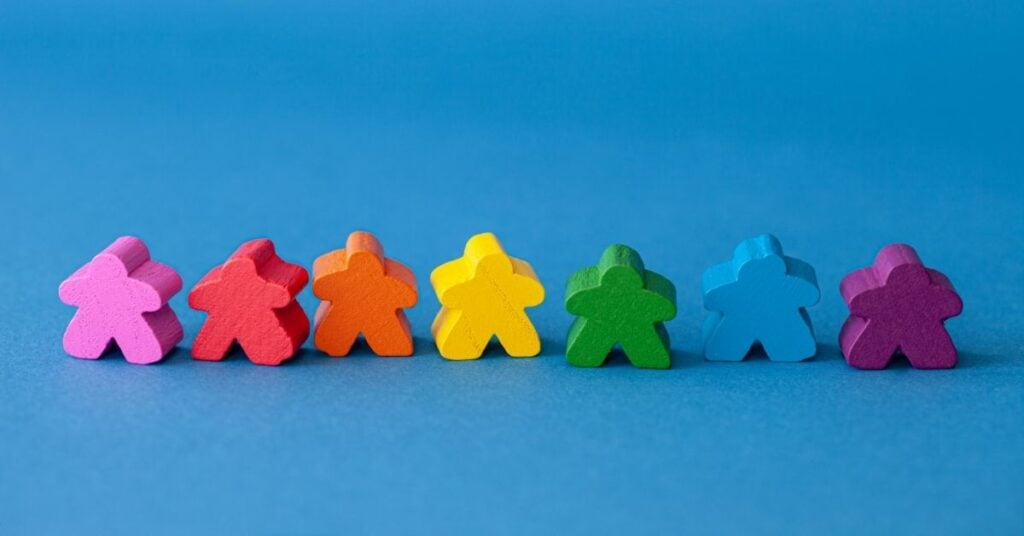What is LGBTQIA+ imposter syndrome?
Reviewed by Susan Radzilowski, MSW, LMSW, ACSW


By the fourth grade, Abby Klingenberg knew she wasn’t straight. By middle school, she had words for her identity. But saying those words out loud didn’t happen until her first year of college.


Klingenberg figured that coming out as bisexual would not be a smooth experience. She grew up in a small Midwestern town and anticipated strong reactions from conservative family members and friends—and in many cases, that was true. Along with the shock and anger she’d imagined, though, Klingenberg was met with a more unexpected emotion: disbelief.
People pointed with confusion to her past relationships with men. Some told her she was “going through a phase” and would eventually return to heterosexuality. Even when supportive friends asked questions to understand Klingenberg’s identity better, she began to feel anxious about having limited knowledge of gay culture and history.
“I didn’t feel like I was queer enough,” says Klingenberg, who has now been out for nearly 10 years. “To this day, even though I’m married to a woman and proudly identify as queer, I don’t feel like it’s enough.”
The sense of accepting your own identity as LGBTQIA+, yet feeling uncomfortable when claiming space in the queer community, is common enough that it now has a name: LGBTQIA+ imposter syndrome.
The origins of LGBTQIA+ imposter syndrome
Coined in the late ’70s by two psychologists, imposter syndrome has gained attention in the era of social media.1 The term refers to a pattern where someone repeatedly questions their own worth and capabilities. A person with imposter syndrome may not believe they deserve success or praise, even if they’ve earned it.
LGBTQIA+ imposter syndrome is an extension of this experience that specifically affects members of the LGBTQIA+ community. Like the original imposter syndrome, this version also involves self-doubt, fear of criticism, and the tendency to compare yourself to others—but for LGBTQIA+ people, the doubt stems not from someone’s internal sense of identity, but from the way they think that identity will be perceived by others. To quote Klingenberg, someone with this type of imposter syndrome worries that they aren’t “queer enough” to be accepted as part of the broader LGBTQIA+ community.
It’s worth emphasizing that a person can be confident in their own self-identity and still experience LGBTQIA+ imposter syndrome. This phenomenon focuses on the discomfort and insecurity that can go along with making that identity known to others.
Signs of LGBTQIA+ imposter syndrome
LGBTQIA+ imposter syndrome can show up in a number of ways. You may be struggling with it if you experience any of the following:
- Being hyperaware of the way you present yourself: This can happen in your daily life with friends, family, and coworkers, or specifically when you interact with other LGBTQIA+ people. You may feel self-conscious about how you speak, dress, or act, and you may be concerned about whether those aspects of who you are live up to how you think someone with your identity is “supposed” to act.
- Feeling that you shouldn’t claim space in the LGBTQIA+ community without the proper “credentials”: You may be aware that you’re LGBTQIA+ but feel like you need to have specific romantic or sexual experiences before identifying outwardly as part of the community.
- Feeling pressure to assign yourself a specific label: Even if you know you’re not straight or cisgender, you may feel the need to put a precise label on your identity. Because gender and sexual identities span such a wide spectrum, this can be difficult or even impossible to do—and that challenge may cause anxiety.
Who does LGBTQIA+ imposter syndrome affect?
Hayden Dawes, MSW, LCSW, LCAS, specializes in working with people of color and the LGBTQIA+ community. In addition to his work as a speaker and therapist, he’s also been a part of research on sexual identity and coauthored an article on the milestones LGBTQIA+ people pass through as they recognize and grow more confident in their identities.2
Among his clients, Dawes notes, bisexual and pansexual people are most likely to experience LGBTQIA+ imposter syndrome. “The disparities for people who are bi and pan are above and beyond people who are monosexual in terms of being gay, lesbian, or straight,” says Dawes. “I’ve seen people question others who might be in heterosexual relationships: ‘Well, are they really bi? Are they really pan?’ It’s quite common.”
The phenomenon isn’t limited to bisexual and pansexual people, though. Dawes views this type of imposter syndrome as part of an internalized struggle with shame and stigma faced by many people in the queer community.
“I mean, these are questions I’ve asked myself as a gay man,” he says. “‘Am I enough?’ ‘Am I good enough?’ ‘Do I belong here?’”
Where does this syndrome come from?
LGBTQIA+ imposter syndrome can be hard to overcome in part because it has no single source. Rather, it’s the result of a variety of internal and external forces, including these:
Heteronormative culture
One major source of LGBTQIA+ imposter syndrome is heteronormative culture. This is the assumption, woven into much of society, that straight, cisgender relationships are the norm. Because of this assumption, LGBTQIA+ relationships are sometimes framed as either abnormal or wrong.
LGBTQIA+ people have to live with the knowledge that others may view their love, and even their existence, as unusual. These ideas can also even creep into their own psyches, resulting in internalized homophobia or internalized transphobia.
Limited representation
Another source of this syndrome is the limited experience some non-LGBTQIA+ people have with the LGBTQIA+ community. Their understanding of what it means to be LGBTQIA+ may come entirely from media representation, which historically has been limited and/or clichéd.3
Straight or cisgender people may expect LGBTQIA+ people to match the stereotypes they’ve seen onscreen, and LGBTQIA+ people may internalize those same popular representations and discredit themselves because how they look or act doesn’t align.
Pressure to be an expert in queerness
Claiming space in the LGBTQIA+ community can be intimidating because of the assumption that it comes with a certain level of insider knowledge. Whether that means cultural references or historical events, LGBTQIA+ people are sometimes expected to have deep knowledge of queer culture at their fingertips.
“I don’t feel like I’m necessarily well-versed,” says Klingenberg, despite her work to consume media that explores LGBTQIA+ themes. “I am trying to put some effort into it, but at the same time, I’m also just trying to live and exist.”
This expectation of expertise doesn’t come only from straight or cisgender people. Dawes cautions members of the LGBTQIA+ community to challenge all forms of gatekeeping, whether it’s internal or directed outward.
“It’s incumbent upon the individual to learn to love themselves,” says Dawes, “and it’s incumbent upon us to not mimic the oppression that has been bestowed on us.”
How can you work through these feelings?
There’s no universal way to become instantly secure in claiming space as an LGBTQIA+ person. However, there are some steps you can take to help grow your confidence over time.
- Build connections in the community. Feeling “less than” or “not enough” is more common than you might realize. Discussing these feelings with friends and acquaintances in the LGBTQIA+ community can help you feel less alone.
- Talk to an identity-affirming therapist. Finding a therapist who supports your identity can make a big difference. Certain types of treatment, such as cognitive behavioral therapy, may help you identify and reframe unhelpful thoughts or negative self-talk.
- Don’t pressure yourself to act in a specific way. Remember that it’s not your job to fulfill anyone else’s expectations. As Dawes says, “You lose your self-integrity by performing in ways you feel like you’re ‘supposed’ to so you can be accepted.”
- Know that it’s okay to skip the labels. You don’t need a defined label to belong to the LGBTQIA+ community. Some people use the umbrella term “queer” to self-identify without limiting themselves.4
- Remember there are no prerequisites. Your experiences—or your inexperience—are valid. You don’t owe an explanation of your romantic or sexual history to anyone.
These suggestions can help you feel more self-assured in presenting yourself to the world, but there’s no finish line when it comes to living as an LGBTQIA+ person.
“You have to come out every single time you meet someone,” says Klingenberg. But as time passes and her support network grows, she’s starting to feel more like she belongs. “There are a lot of things that have helped me become more confident and secure in who I am,” she says. “And who I am is so much tied to my queerness.”

Sources
1 https://www.forbes.com/sites/conormurray/2023/05/08/what-to-know-about-imposter-syndrome-the-psychological-phenomenon-making-people-doubt-their-success/?sh=60d3b3a260d2/
2 https://www.frontiersin.org/articles/10.3389/fpsyg.2021.753954/full/
3 https://www.tandfonline.com/doi/abs/10.1080/13676261.2016.1184243/
4 https://www.them.us/story/what-does-queer-mean/
About the author
Kirsten Fuchs is the content production manager at therapist.com. She’s excited to be pairing her copywriting expertise and love of written language with the support and clinical insights of the therapist.com team.
Related articles

Internalized homophobia, biphobia, and transphobia
LGBTQIA+ people who are surrounded by negative messages about their identity...

Nonbinary people and mental health
Nonbinary people have a gender identity outside the traditional categories of...

Creating a welcoming space for LGBTQIA+ clients
An LGBTQIA+-friendly practice isn’t the same as an LGBTQIA+-informed one...

When your religion rejects you, what comes next?
Healing from religious trauma can be especially hard for LGBTQIA+ people, who...
